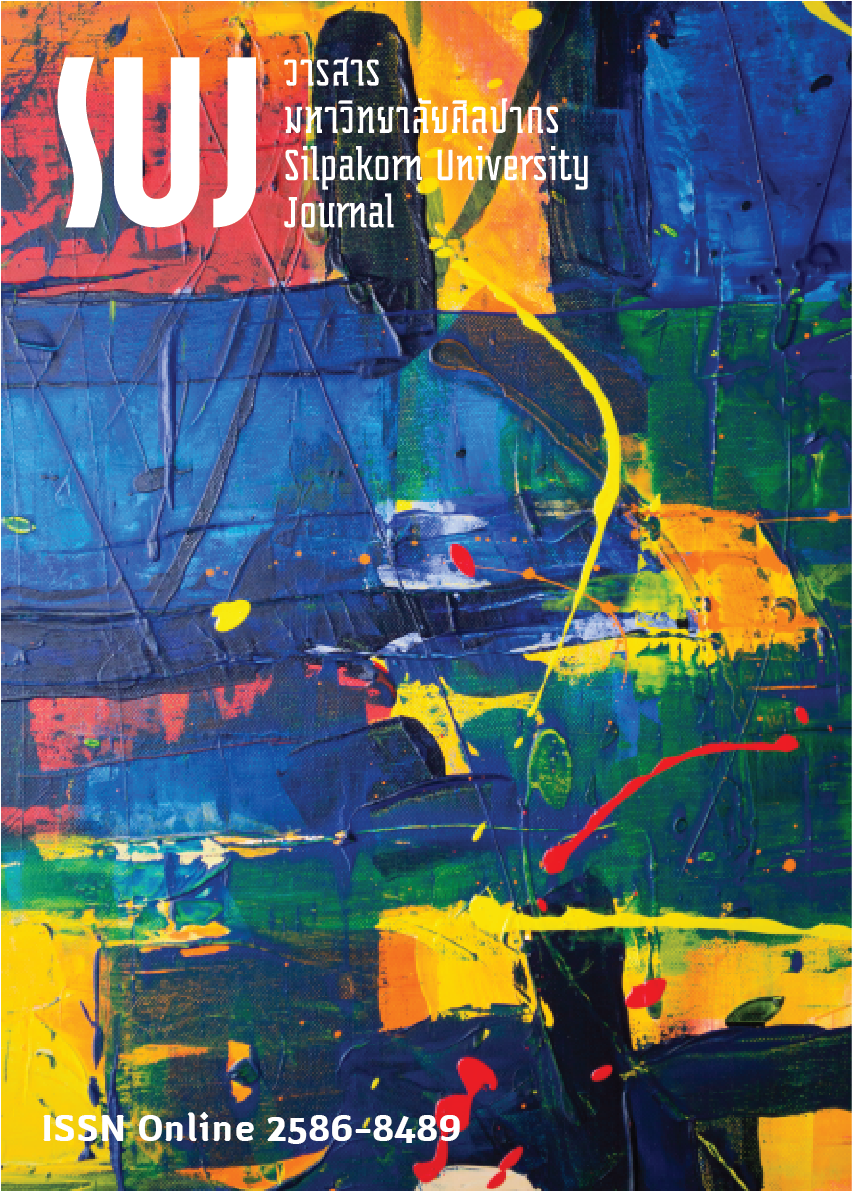การพัฒนารูปลักษณ์วัสดุเพื่องานเครื่องประดับสานต่อความพอเพียง (The development of materials’ appearance for jewelry pieces in association with the philosophy of sufficiency economy)
Main Article Content
Abstract
งานวิจัยนี้มีเป้าหมายในการนำวัสดุจากโครงการอันเนื่องมาจากพระราชดำริ ในพระบาทสมเด็จพระเจ้าอยู่หัว รัชกาลที่ 9 พื้นที่ภาคตะวันตกของประเทศไทย มาพัฒนาศักยภาพและรูปลักษณ์เพื่อให้ได้วัสดุใหม่สำหรับงานเครื่องประดับด้วยกระบวนการผลิตที่สอดคล้องกับหลักปรัชญาเศรษฐกิจพอเพียง โดยในขั้นตอนการศึกษา ผู้วิจัยได้ค้นหาหลักการพัฒนาพื้นที่ภายในโครงการอันเนื่องมาจากพระราชดำริฯ พื้นที่ภาคตะวันตกของประเทศไทย ควบคู่ไปกับการค้นหาวัสดุทางธรรมชาติภายในโครงการ ซึ่งเป็นวัสดุที่มีความสำคัญในเชิงพื้นที่ สามารถบ่งบอกถึงสภาพภูมิประเทศและวิถีชีวิตของผู้คน และทำหน้าที่พลิกฟื้นดิน ป่า แม่น้ำให้อุดมสมบูรณ์ขึ้น จนสามารถค้นพบแนวทางการพัฒนารูปลักษณ์ของวัสดุได้ 3 แนวทาง ได้แก่ 1. การมุ่งเน้นการเคารพภูมิสังคมและศักยภาพของทรัพยากรธรรมชาติด้วยการคงเดิมด้านสีสันและผิวสัมผัสเอาไว้ ซึ่งสะท้อนถึงการเคารพในศักยภาพของทรัพยากร 2. การผสานเทคโนโลยีการผลิตที่พึ่งพาตนเองได้ ด้วยการใช้เครื่องมือสำหรับทำเครื่องประดับเข้ามาขับเคลื่อนศักยภาพของทรัพยากร 3. การบูรณาการเทคนิคและเครื่องมือในการทำเครื่องประดับชนิดต่าง ๆ เข้าด้วยกัน เพื่อสร้างรูปลักษณ์ใหม่ให้กับวัสดุ ซึ่งทั้ง 3 แนวทางนี้สามารถสร้างผลลัพธ์หรือก่อให้เกิดประโยชน์อย่างสูงสุดในการใช้ทรัพยากรให้สอดคล้องกับหลักปรัชญาเศรษฐกิจพอเพียงผ่านผลงานเครื่องประดับร่วมสมัยเพื่อสื่อสารให้เห็นถึงคุณค่าในแง่มุมของการสร้างสุนทรียะแห่งความยั่งยืน
This research explored the potential of the raw materials derived from the Royal Projects of King Bhumibol Adulyadej, mainly in the western part of Thailand. This is to generate innovative features from the materials to use in jewelry design in concordance with the philosophy of self-sufficiency economy. The research began with the establishment of the framework for the royal land reform development projects in the western region of Thailand and with the process to find appropriate natural materials which reflect the geographical identity and lifestyles of local people, and have an important role in rehabilitating the natural environment. As a result, the research suggested three approaches to materials development. The approaches are 1. to respect the power of Nature by preserving the natural colors and textures, 2. to maximize the potential of existing resources by utilizing tools and jewelry making techniques, and 3. to provide innovative features of jewelry by integrating different techniques and tools in jewelry making. In conclusion, these three directions create the maximum result without the complexity of the process that consonant to the philosophy of self-sufficiency and translated the sustainable aesthetics through contemporary jewelry.
Downloads
Article Details

This work is licensed under a Creative Commons Attribution-NonCommercial-NoDerivatives 4.0 International License.
References
NellyRodi. (2019). NellyRodi: Life & Style: 2019. France: Trendlab S.A.S.
Office of the Permanent Secretary for Education. (2017). The “23 Work Principles” of His Majesty King Bhumibol Adulyadej (23 หลักการทรงงานพระบาทสมเด็จพระเจ้าอยู่หัว ในหลวงรัชกาลที่ 9). [Online]. Retrieved February 3, 2017 from https://shorturl.asia/G0ORF
Silpakorn University. (2019). 5-year Development Plan Silpakorn University (แผนพัฒนามหาวิทยาลัยศิลปากร ระยะ 5 ปี). [Online]. Retrieved May 14, 2020 from https://shorturl.asia/9uOPf
Sufficiency Economy Learning Center. (2017). The Meaning of Sufficiency Economy (ความหมายของเศรษฐกิจพอเพียง). [Online]. Retrieved March 2, 2017 from http://www.kwicec.ac.th/web58/index.php/2-uncategorised/1-2018-03-25
Tantivejkul, Sumet. (2010). Under the Feet of a Sovereign (ใต้เบื้องพระยุคลบาท). Bangkok: Matichon Publishing.


